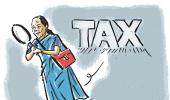96 per cent is being collected through TDS, advance tax, self-assessment tax, and other receipts.

A smaller proportion of direct tax collections involves the income-tax department running behind taxpayers than was the case a decade ago.
Around 78.4 per cent of total gross direct tax receipts come in through tax deducted at source (TDS) and in the form of advance taxes in 2022-2023 (FY23).
It was 76.4 per cent in 2013-2014. The total value of taxes collected through these routes is Rs 15.5 trillion, the highest in data going back to 2000-01.
It was Rs 10.2 trillion in 2018-2019 before the pandemic.
There have been fluctuations in individual years, but the share of these routes has broadly shown a rising trend.
The TDS route refers to payments being made after retaining tax, such as when a company deducts taxes before paying the salary of an employee.
Advance taxes are paid ahead of the amounts becoming due. All of the amounts are paid directly to the I-T department.
Other categories include self-assessment tax, regular assessment tax, and other receipts such as wealth and dividend distribution taxes.
"In addition, self-assessment taxes are also partly automatic as taxpayers true up at year-end without intervention. Only a very small percentage comes from tax collections made on account of audit assessments and litigation wins against taxpayers," said Rohinton Sidhwa, partner, Deloitte India.
Sameer Gupta, tax leader, EY India, said that only around 4 per cent of gross direct tax receipts were collected through regular assessment tax.
This indicates that 96 per cent is being collected through TDS, advance tax, self-assessment tax, and other receipts.
"It may not be appropriate to assume that the collections from TDS, etc, do not involve (the) department's additional operational expenditure," Gupta said.
"Like other tax administrations worldwide, India is also incurring operational expenditure on the technology changes, using sophisticated analytics, systems of taxpayer registration and identification, the structure of the workforce and so on," Gupta explained.
"According to a recent Organisation for Economic Co-operation and Development survey of 43 leading jurisdictions, over 81 per cent of total personal I-T collections were withheld at source in 2021," added Gupta.
"India too has been relying more and more on TDS/tax collected at source with a view to plug any tax leakages and also to be able to gather greater data intelligence," noted Gupta.

Recently released I-T department figures show that the cost of collection has fallen to 0.51 per cent of the total collections.
It was 1.36 per cent in 2000-2001. A back-of-the-envelope calculation shows that the cost of collection excluding TDS and advance tax has remained stagnant.
It was around 2 per cent in FY23. The value for 2010-2011 was also 2 per cent.
Further reliance on TDS or TCS and increased use of technology could bring down costs further, according to some.
"If the government continues to ramp up rates or levy TDS/TCS on more transactions," added Sidhwa, "there is a potential to increase the proportion (of 'automatic' collections)... Faceless is yet to be fully implemented. If audits are completed using technology... then the cost can further decline."
Feature Presentation: Aslam Hunani/Rediff.com











